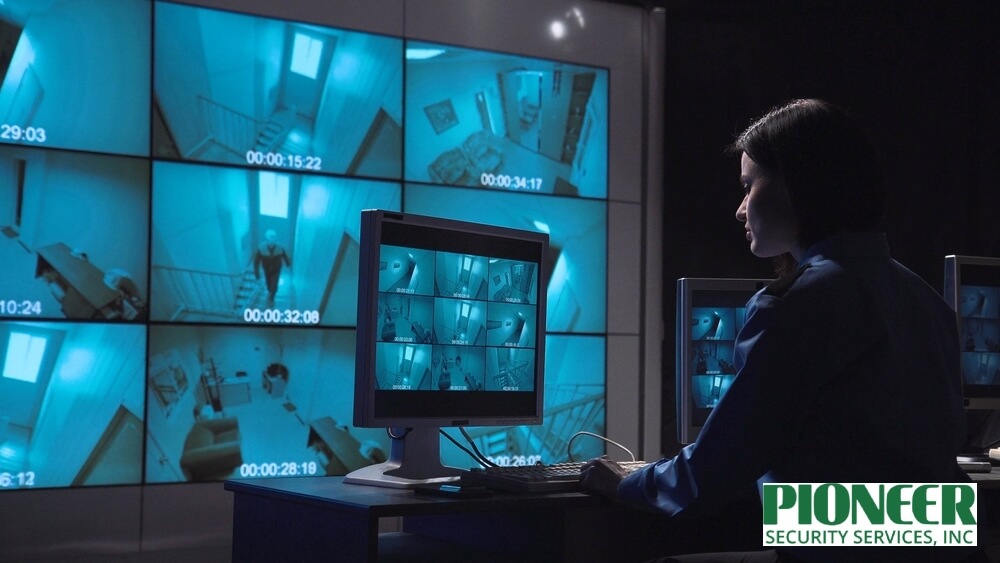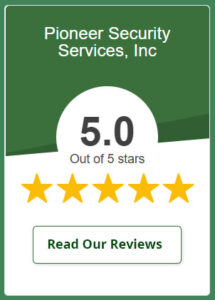Traditional alarms and live video monitoring serve similar goals, protecting property and people, but work very differently. A conventional alarm fires only after a breach, for example, when a window is broken or a door is forced open, it alerts once the damage is already underway.
By contrast, live video monitoring combines real-time cameras, human operators, and AI/analytics to detect threats as they emerge, issue warnings, and intervene if possible, thereby preventing issues from escalating. Alarm systems have a significant problem with false alarms: between 94% and 98% of burglar alarm activations in the U.S. are found to be false alarms. This means that only 2-6% of alarms actually correspond to real intrusion events.
In this article, we’ll offer a side-by-side comparison of both systems, describe the benefits and drawbacks of each, and help you decide which is best for your business, your residence, or your particular security needs.
What Is Live Video Monitoring?
Live video monitoring is a proactive security service that pairs continuous camera feeds with automated analytics and human operators to detect, verify, and respond to suspicious activity in real-time. It doesn’t wait for a sensor to trip. Instead, it monitors events as they occur, verifies whether they are genuine threats, and responds immediately to mitigate harm.
Three-quarters of large federal agencies are using at least one facial recognition technology within their departments, with additional implementations planned to be deployed through 2023, according to a new report from the Government Accountability Office.
How it works (step-by-step):
- Cameras capture live video 24/7, indoors and outdoors.
- On-camera analytics (AI) scan the feed for preconfigured behaviors, for example: loitering, perimeter breaches, wrong-way movement, or objects left behind.
- When the AI flags a potentially suspicious event, a trained operator reviews a short clip or live view to confirm whether it’s a real incident.
If the operator verifies a threat, they can take immediate non-violent actions, such as sending two-way voice warnings through on-site speakers, locking electronic doors, alerting on-site staff, or dispatching a private security patrol.
If the situation escalates or a crime is in progress, the operator contacts emergency services and provides precise, verified information, along with video evidence, to expedite the response. Because verification happens before escalation, live monitoring is fundamentally proactive.
It reduces unnecessary police dispatches and false alarms by filtering out benign triggers, such as animals, weather, or staff movement, before authorities are called. Industry implementations report significant declines in false dispatches when video verification is used. Every false alarm needs to be assessed and acknowledged, which takes approximately 15 seconds per incident.
Live monitoring also enables faster and more informed responses. Combined with analytics, human operators can prioritize real threats and supply first responders with time-stamped video and location details, thereby improving situational awareness and evidence collection.
However, it relies on good camera placement, robust connectivity, and trained operators to be effective. Studies of CCTV and monitored video have shown significant crime-reduction effects in many areas, particularly in vehicular parks and residential areas.
What Is a Traditional Alarm System?

A traditional alarm system depends on discrete sensors and a central alarm panel to detect breaches and notify stakeholders. Standard components include door and window contacts, motion detectors, glass-break sensors, control panels, sirens, and sometimes monitored panic buttons. These systems are designed to react the moment a sensor detects an intrusion or trigger.
How traditional alarms operate:
- A sensor (for example, a magnetic contact on a door) senses a breach or motion.
- The control panel receives the trigger and typically sounds an on-site siren to deter intruders.
- If the system is monitored, it sends an alert to a monitoring center. The monitoring center then follows a preset protocol: attempt contact with the premises, notify the account holder, and, if verification fails or if policy dictates, call the police.
- If unmonitored, the system relies entirely on the local siren and neighbors to notice and call for help.
Traditional alarms are inherently reactive. They notify after a threshold has been crossed, which means damage or entry may already have occurred. They also depend heavily on third-party responses, such as a security company’s callout or police dispatch. In practice, that reliance can limit practical outcomes.
For example, burglary clearance rates in the U.S. have historically been low; recent summaries indicate that burglary clearance rates (cases solved/arrested) are in the low-teens percent range, underscoring that a police response does not guarantee recovery or arrest. Residential burglary rates in cities with 500,000 to 999,999 residents were twice as high as in towns with fewer than 100,000 people.
False Alarms:
A critical operational downside is the occurrence of false alarms. Research indicates that the vast majority of burglar alarm activations are not related to actual crimes. A widely cited review reports that 94–98% of burglar alarm activations are false alarms in many jurisdictions, resulting in significant administrative and operational burdens for police and security services.
This high false-alarm rate has led many agencies to de-prioritize unverified alarm calls. For readers who want the original analysis, see the ASU Problem-Oriented Policing Center’s “False Burglar Alarms, 2nd Edition” page: False Burglar Alarms.
Bulleted summary of the practical differences (concise):
- Reaction vs. prevention: Traditional alarms react after a trigger; live monitoring seeks and intervenes as events unfold.
- Verification: Live monitoring verifies with video before escalation; alarms often trigger a response without visual confirmation.
- False alarms: Traditional alarms generate far more false dispatches; video verification dramatically cuts unnecessary calls.
- Evidence & deterrence: Live video supplies immediate visual evidence and can deter in-progress crimes through voice downlinks; traditional alarms primarily rely on sirens and subsequent response.
Both approaches still have a role. Traditional alarms remain simple, cost-effective deterrents for many homes and small businesses. Live monitoring offers verification, rapid intervention options, and richer evidence, making it more suitable for larger properties, high-risk sites, and areas where reducing false police dispatches is a priority.
For factual grounding on the prevalence of false alarms and policy implications, consult the ASU POP Center overview.
Key Differences Between Live Monitoring and Traditional Alarms
Below are the core comparisons, broken down into specific dimensions, to illustrate how live video monitoring differs fundamentally from traditional alarm systems.
Real-Time Prevention vs Reactive Alerts
Live video monitoring is designed to act before damage or intrusion happens. With cameras, AI, and human operators, it can detect suspicious behavior (such as someone loitering, climbing a fence, or breaking a window) as it happens, intervene (e.g., issue warnings, call security, or law enforcement), and thus prevent theft or vandalism.
In contrast, traditional alarms only alert after the trigger. For example, the motion sensor triggers when a window is broken or a door is forced open. Damage may already be done by then.
Example:
A jewelry store with live monitoring detects a person trying to pry open a back door at 3 AM. An operator issues a warning over speakers, and the intruder flees before entry. Contrast that with a shop using only a motion detector, sensor triggers, and siren sounds, but the thief has already entered, stolen items, and left by the time police arrive.
False Alarm Rates and Verification
Traditional alarms suffer extremely high false alarm rates. Research from the Arizona State University Center for Problem-Oriented Policing (POP Center) indicates that the false alarm rate for burglar alarms ranges from 94% to 98%.
Live video monitoring and video verification significantly reduce false positives by incorporating human verification and visual evidence before dispatching police. For example, requiring video verification has been shown to reduce false alarms by around 90% in jurisdictions that adopt verified response policies.
Response Times and Police Dispatch
When a video or live operator verifies an alarm, law enforcement tends to give priority to those alarms. Verified alarms are treated as credible threats in progress.
Meanwhile, unverified traditional alarms often result in delayed responses or even deprioritization by dispatch services due to the sheer volume of false alarms. In many places, policies require verification before dispatch to avoid overstretching resources.
Cost and Long-Term ROI
The initial monthly cost for basic traditional alarm monitoring often ranges between $20 and $60 per month. More comprehensive live video monitoring services typically cost between US$50 and $200/month, depending on the features (such as AI, video analytics, the number of cameras, and integration).
However, when considering ROI, live monitoring can lead to fewer thefts, less property damage, and lower insurance premiums. For instance, businesses switching to video-verified monitoring report significant reductions in losses; one report cited a 70% drop in incidents for properties using remote video monitoring compared to those relying solely on alarms.
Insurance companies often offer discounts for systems with verified response or video verification, because the risk is demonstrably lower. Also, fines for false alarms are avoided with video verification. This improves cost-effectiveness over time.
Technology and Integration Capabilities
Live monitoring systems integrate with modern technology, including AI-powered video analytics (such as loitering detection, facial recognition, and object left behind), cloud storage, access control systems (for doors, gates, and smart locks), mobile apps, and integration with IoT sensors. These enable centralized control, remote viewing, and detailed logs.
Traditional alarms are more limited. They typically feature sensors, motion detectors, door/window contacts, and wired or wireless communication to an alarm panel and a monitoring center. They typically lack visual verification or AI analytics and do not integrate as well with cloud systems or advanced threat detection.
Benefits of Live Video Monitoring Over Traditional Alarms

Here are the primary advantages of selecting live video monitoring over traditional alarm systems. Each benefit is based on the differences outlined above.
1. Proactive Deterrence and Crime Prevention
Because live monitoring enables operators to detect threats as they form, and to utilize tools such as two-way voice warnings, loudspeaker announcements, or automated alerts, many potential intruders flee before committing a crime. The visible presence of cameras, combined with the knowledge that the system is monitored in real-time, acts as a deterrent.
2. Reduced False Dispatches and Police Fines
False alarms often result in police dispatch, as well as municipal fines. Cities impose fees for repeated false alarms or even reduce the priority of response. With live monitoring and verification, false alarms are filtered out before police are called. This avoids fines, saves time and resources, and reduces legal or insurance liabilities.
3. Enhanced Coverage for Large or Complex Properties
Large campuses, industrial sites, warehouses, or business parks have many potential breach points. Live video monitoring can survey a wider area, using fewer personnel but more tech (cameras + analytics).
It scales better than traditional alarm sensor-by-sensor coverage. Additionally, complex layouts are more challenging to cover with basic sensors alone; camera placement with monitoring, combined with integration into access control, ensures better perimeter control, interior coverage, and remote oversight.
4. Greater Peace of Mind for Business and Homeowners
Knowing someone is watching in real-time, verifying threats before escalation, ensures safety is less dependent on chance (such as someone hearing a siren or neighbors noticing). For both business and residential settings, that means sleep, operations, or assets are better protected. Additionally, in emergencies, verified video provides footage that aids law enforcement or insurers.
Benefits of Traditional Alarm Systems
Although live video monitoring offers numerous advantages, traditional alarm systems still retain value in many situations. Below are some of their key benefits.
1. Lower Upfront Costs and Easier Setup
Traditional alarms are often affordable to buy and install. Basic DIY alarm kits (with door/window sensors, a control panel, and motion detectors) can cost $100–$500 to set up. Professional installation for more full-featured alarm systems typically ranges $600 to $1,500.
You can avoid high labor fees by choosing wireless or self-installed systems. Many kits come with detailed instructions. This makes it simpler for homeowners or small businesses to deploy them without waiting for technicians.
Also, maintenance tends to be simpler. Fewer moving parts, no video storage to manage, lower bandwidth or hardware demands reduce ongoing technical complexity.
2. Familiarity and Widespread Adoption
Many homeowners and business operators are already used to alarms. They know how they work and often feel confident in their reliability.
Alarm systems have been the standard for decades. Firms like ADT and Vivint have a large number of residential and commercial property installations. This leads to broad support, easy service availability, and a range of familiar models.
Due to their ubiquity, parts and replacement sensors are readily available. Many local security firms support traditional alarms, resulting in prompt repair or upgrade work.
3. Basic Protection for Low-Risk Environments
For low-crime neighborhoods or smaller properties, alarms provide a meaningful layer of deterrence and warning.
If you live in an apartment building, a quiet rural area, or a well-policed suburb, the risk of intrusion may be low. In such cases, the alarm’s siren and sensors may be sufficient to alert neighbors or authorities when a breach occurs.
One study of burglary security devices in England and Wales found that combinations of external lighting, window locks, and simple alarm devices confer up to 20 times greater protection than no security at all in many low-risk settings.
Traditional alarms also consume less infrastructure, with no constant video streaming, reduced battery or power demand, and fewer bandwidth needs. That makes them suitable for environments where technology maintenance or high-speed internet isn’t reliable.
Which Is Right for You: Live Video Monitoring or Alarms?
Making the correct choice depends on your property’s risk level, budget, and security goals. Below are guidelines on when each fits best and how you can combine them for stronger protection.
Best Use Cases for Live Video Monitoring
Live video monitoring is advisable when there is a high risk or high value involved. Here are prime situations:
- Businesses with high-value inventory (jewelry stores, electronics warehouses, laboratories).
- Large facilities or campuses with extensive perimeters and multiple access points.
- Areas with frequent thefts, vandalism, or where sirens alone are not sufficient to stop intrusions.
- Locations where insurance discounts are available for video verification or monitored video systems. Verified systems often result in lower premiums because insurers view them as lower risk.
In these cases, the higher monthly cost of monitoring can be offset by fewer losses, deterrence, and a faster response.
Best Use Cases for Traditional Alarms
Traditional alarm systems are better suited when:
- The property is low-risk: small homes, apartments, or residences in neighborhoods with low burglary rates.
- Your budget is constrained, and you need basic, functional protection without monthly costs or technical maintenance.
- Internet connectivity or electrical infrastructure is unreliable, making video systems harder to maintain.
You only need to be notified after a breach, and are comfortable depending on local law enforcement or neighbors for response.
If you don’t require live verification or two-way intervention, a well-installed traditional alarm can provide an acceptable level of safety.
Combining Both Systems for Maximum Security
Many users benefit from a hybrid approach, which combines the use of alarms for immediate breaches with video monitoring for verification and real-time intervention.
Use alarm sensors as the first layer, including door and window sensors, motion detectors, and glass-break sensors. These trigger sound alerts or sirens to scare off intruders.
Pair them with video cameras aimed at high-risk entry/exit areas, with remote monitoring so that any alarm can be verified visually. This avoids false dispatches and improves response legitimacy.
Examples: in commercial settings, alarms protect internal zones, while video protects perimeters and provides evidence. In residences, basic alarm coverage, combined with a camera at the main entry door, provides both deterrence and verification.
Hybrid systems often deliver better ROI: you get the lower upfront cost and simplicity of alarms, combined with the proactive deterrence and evidence benefits of live video systems. Over time, that means reduced losses and more reliable security.
Choose the Right Security Solution with Pioneer Security
Traditional alarm systems remain a practical choice for many homes and small businesses because they are straightforward, familiar, and budget-friendly. However, they are inherently reactive, alerting you only after an intrusion or emergency has already occurred.
Live video monitoring, by contrast, offers proactive and advanced protection by combining real-time cameras, AI, and trained operators to identify and stop threats before they escalate.
When deciding between these options, assess your property’s risk level, the value of the assets you’re protecting, your budget, and any privacy or compliance obligations. Low-risk residential spaces may be well served by a basic alarm, while high-risk industries, large campuses, or businesses with high-value inventory benefit from live monitoring or a hybrid approach.
If you’re considering upgrading your security, Pioneer Security can help you evaluate your needs and design a tailored system. Explore our services or request a consultation today to find the right blend of protection for your property.
Frequently Asked Questions
Are traditional alarms still effective today?
Yes, traditional alarms reliably detect intrusions through door, window, and motion sensors, triggering sirens or notifications. They work well as a deterrent, especially in low-risk areas, but only alert after a breach occurs.
Why is live video monitoring considered more secure?
Live video monitoring provides real-time visibility with cameras, operators, and AI. Suspicious behavior can be detected early, warnings issued, or law enforcement alerted, offering stronger deterrence than alarms alone.
Can live video monitoring fully replace alarm systems?
Not entirely. Video systems depend on cameras and connectivity, while alarms detect smoke, carbon monoxide, or water leaks. A hybrid approach combining both provides maximum coverage and reliability.
Which option is more cost-effective long-term?
Traditional alarms are cheaper upfront, but video monitoring can reduce theft, speed response, and lower insurance claims, often offsetting higher monthly costs—especially for high-risk or high-value properties.
Do insurance companies prefer video monitoring?
Yes, insurers favor professionally monitored systems with visual verification. Combining cameras and monitored alarms often results in the largest premium discounts, while unmonitored systems yield smaller or no savings.
Is video monitoring legal everywhere?
Video monitoring is generally legal, but privacy and consent rules vary. Avoid recording private areas, follow local audio laws, and comply with data protection and signage requirements.



